|
TennisOne Lessons
From Dinker to Accomplished Player.A Blueprint for Success! By David Smith
"Uh, hi, everyone. My name is Dave," I said with a slight crack in my voice. I surveyed the room. Everyone had a tennis racquet in his or her hand. "Hi Dave!" the group replied with compassion and warmth. "I, uh, guess you all know why I'm here," I said with apprehension, feeling like I did when I was 10 about to get a flu shot. They all nodded at me with understanding. A large poster on the wall announced the group's creed: 'I have a dinking problem. I will not dink.' I began to wonder what I had gotten myself into! Kidding aside, I have taught tennis for 30 years and have seen how players who play tennis within a "dinker's" mentality or strategy often resist or even deny they have a dinking problem. That got me thinking of the analogy to someone with a drinking problem. Okay, it's a stretch, I know. so sue me. But when you think about it (and here you have to use your imagination) I believe there are similarities between having a drinking problem and being a tennis dinker. Both require a dedication to avoidance of the problem; both are developed through bad habits or poor choices; both can stifle a person's ability to reach their potential and their goals. And for a cure, both require the person to first acknowledge they do indeed have a problem. Recognition and Desire Unless a player recognizes they have a "dinking" problem, making the necessary changes and creating a sincere desire to execute such changes will be virtually impossible. And this involves a clear understanding of the limitations that dinking presents in their current game. Unfortunately, many dinkers don't believe they even have a problem. "I can play 'real' tennis, I just like to dink the ball to throw off my opponents, and besides, I'm winning aren't I." such players report. However, most dinkers never make it past the 3.0 or 3.5 levels of play. Many believe that through some magical event they will suddenly possess prolific strokes. While there is really nothing magical about being able to play skilled tennis, millions of players who do resort to dinking believe that those players who moved out of low levels of play must either be very gifted or do indeed have some magical secret that separated them from those who dink. Neither of these conclusions is correct. Skilled tennis is achievable by almost all who wish to achieve it.
Blueprint to Success Making the transformation from dinker to skilled stroke practitioner takes incremental steps. Because the changes are usually difficult and frustrating, these steps are required to make the task manageable. Even so, such a transition is usually so difficult and frustrating that some who know they need to take such steps sadly fail in completing the process. Such failure, of course, dooms a player to a life of tennis-mediocrity! Understand too, that since most beginners usually play tennis first within some dinking criterion, these steps are applicable to the beginner player as well as to the long-standing dinker. (This is the obvious connection as to why calling someone a "dinker" is a tennis-put down! Imagine buying a Steinway piano and playing it for ten years.and after ten years all you can play is Chop Sticks!) The number one factor in a player resisting change to more skilled strokes is the grip. Because the grip can affect so many critical aspects of strokes and technique, I find it the most glaring culprit to the dinking mentality. And the most difficult grip to master is the continental grip. This grip is used by most skilled players to execute forehand and backhand volleys, serves, overheads, and two-handed backhands. (There are some exceptions to this, which I do acknowledge. However, the issue here is that other grips often contribute to faulty play for many, or they are too close to what the player is already using to dink the ball!) Because so many strokes are dependent on the player's ability to use this grip, the player must become accustomed with it to the point of familiarity. Advice on Learning Grips Sleep with your racquet while holding the continental grip. OK, just kidding. But the concept is sincere: Like anything difficult to master, you must spend a lot of quality time physically connected correctly to the task. Comfort and familiarity with the RIGHT grip is key to producing strokes with the RIGHT grip! When on the court, make sure you are holding a continental grip ALL the time between points, during changeovers, in clinics and lessons.anytime you are holding your racquet!
Finding the Continental Grip
Step 2: Bouncing and Catching Tools These three tools will help speed up the acclimation process of grips. They can and should be done many times a day between lessons or hitting sessions. A dedication of just ten to fifteen minutes a day working these drills can get you comfortable with the continental grip with a week. They all can be done at home on a patio, garage floor, sidewalk, etc. The important point to make here is to be sure you are using the continental grip and not migrating over to the more comfortable eastern forehand grip.
Step 3: Keep the Plane the Same
The number one fault in hitting groundstrokes (and volleys too) is "rolling the racquet." This is the action of the racquet face open prior to contact then closing as the ball is struck. While many players associate hitting topspin with this technique, it not only produces something other than topspin usually, it prevents the player from learning how to aim. This is because the racquet face is changing during the critical phase of contact. A player who hits a little to early will have the racquet face too closed; too late, the face is too open. No matter what grip or swing pattern you choose, the critical issue is what I call "keeping the plane the same." The racquet face must not vary before contact and just after contact if the player is going to create a consistent contact point. Adding topspin requires the player to simply accent the vertical aspect of the swing path. Even in hitting a slice stroke, the racquet must move down and through the ball with the racquet face locked. If the player "dishes" the ball, or cupping under the ball during contact, again we have a racquet face that is not constant.
Step 4: Swing Path On the serve: Most dinkers use the common eastern forehand grip, stand facing the net, and swing flat in a linear path towards the target; basically, steering the ball into the court. Skilled servers predominantly use the continental grip, stand sideways to the court, and brush across the ball as they hit it. There is a great drill to accommodate the issue of grip and brushing action. It is our "Down Bounces" but done standing and done with the racquet brushing the right side of the ball. (For right-handed servers.) To help control the bounces start hitting the ball flat and work your way over to actually brushing the right side of the ball. Initially, the ball will squirt out to the left. But with practice, the player will use both aim and the return spin of the ball to come back up for repetitive bounces. This drill helps players feel the spin as well as learn how the racquet makes contact for the serve. The foundation of a spin serve's swing path will mimic the action of the racquet moving across the ball during this drill. The player will need to stand sideways, with his toss arm's shoulder pointing towards the target.
When learning to hit the spin serve, it is better to shorten the backswing to allow the player to control the racquet's action. Speed is not the issue at this point; learning to brush the ball and learning how the spin affects the ball's flight is. Learning to control the aspect of spin will open the door to three things:
The simple fact that a player can hit a bigger second serve also opens the door to go after the first serve with a more aggressive attack. Those who fear their own second serve often temper their first serve so they don't have to hit their second serve! While there is great diversity in the forehands of most skilled players, the foundation of learning to hit with topspin (or slice) follows our earlier step of "keeping the plane the same." No matter what grip you work on, the racquet must move forward, from low to high, to enact topspin on a ball. In addition to rolling the racquet, a problem mentioned earlier, many players over rotate on the stroke when learning to hit topspin. That is, they let their back leg swing around during contact. This action brings the racquet around too early, forcing the player to push the racquet through the target.
When learning to hit topspin, keep your body balanced by keeping the back foot down through contact. This will allow you to drive through the ball with angular momentum, creating a fluid and efficient swing with topspin. Learning with this "closed stance" platform in no way prohibits a player from learning open stance strokes later, once the swing path is established. Swing Path: Volleys and Slice Strokes Volleys and slice groundstrokes are both "linear" strokes. That is, the racquet moves down and through the ball in line with the target. For this action to occur correctly, the player must stay sideways through contact. Typically, a dinker will face the net and simply push the ball flat in the intended direction. When a dinker initially tries to hit a slice groundstroke or volley correctly, they usually hit too much under the ball and the ball floats up and short. A helpful image for dinkers to learn the slice groundstroke is to aim at the bottom of the net while slicing the ball. This usually creates the proper racquet position when actually trying to hit a slice, (compared to their perception of aim when they dink.) After understanding the concepts presented here in this article, the many instructional articles presented in the TennisOne Lesson Library will have greater meaning and value to the student. Learning the continental grip, keeping the plane the same, and swinging with the right swing path will help all players develop the patterns of play these articles present. Remember, skilled tennis strokes are seldom initially familiar or comfortable. Whether you are a beginner or a seasoned "dinker", these changes will create frustration and discomfort. Using the tools presented in this article will help limit such experiences and increase the likelihood of continued improvement and success in every individual. Your comments are welcome. Let us know what you think about Dave Smiths' article by emailing us here at TennisOne.
|
||||||||||||||||||


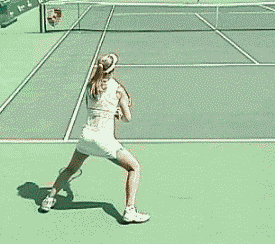 Footwork, racquet control, hand-eye
coordination and timing will all contribute to a competent tennis stroke.
Here, Meghann Shaughnessy generates ample topspin through her “modern
forehand” stroke.
Footwork, racquet control, hand-eye
coordination and timing will all contribute to a competent tennis stroke.
Here, Meghann Shaughnessy generates ample topspin through her “modern
forehand” stroke.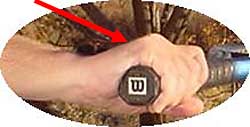
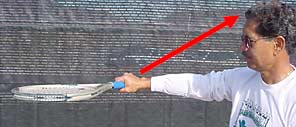
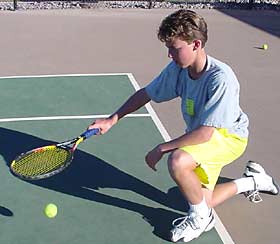
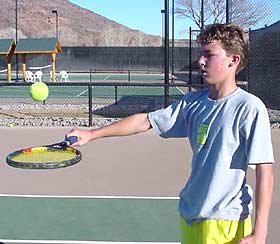
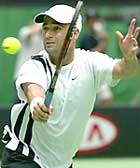
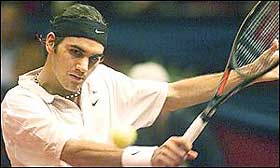
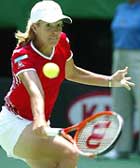

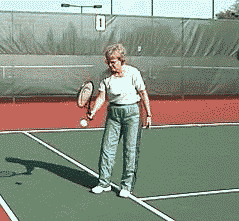
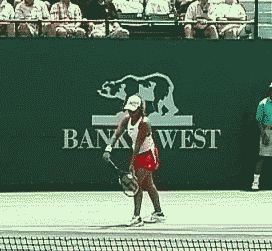
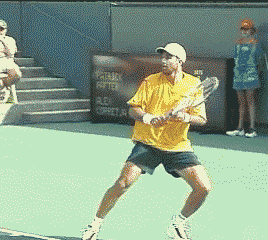
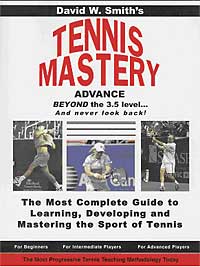
 Your comments are welcome. Let us know what you think about this article by
Your comments are welcome. Let us know what you think about this article by